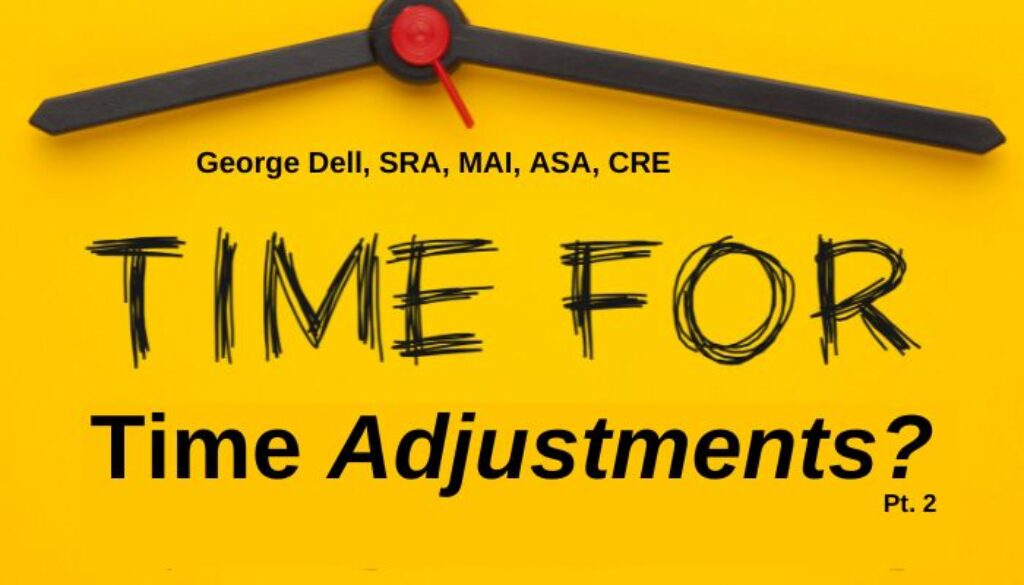Time adjustments have long been required as good appraisal practice. On the residential side, they are required in guidelines issued by FannieMae and FreddieMac (the GSEs).
Unfortunately, the requirement for time adjustments (“market conditions”) has been ignored by the lenders selling to the GSEs (Government Sponsored Enterprises). Why?
Editor’s Note: Read Part 1 of this series here.
Here we seem to have a case of a fundamental fallacy: the fallacy of insufficient reason — It’s too hard, so let’s avoid it. Worse yet, this bias-causing fallacy is embedded in bureaucratic policy, and by extension, failure of enforcement by the GSEs and several agencies. We go from group-think, to org-think, to ignored-rule-think. I think.
All this in the face of an appraisal standard where USPAP requires analysis of supply and demand, and market area trends. Any conclusion that the market is going up, down, or level – requires “support.” An “unsupported assumption or premise about market area trends” must be avoided! (Rule 1-3(a))
In a recent paper written by Scott Susin, FHFA senior economist, the research shows that:
- Appraisers tend to do time adjustments last (as a fudge factor?)
- If the appraised value is “high enough”, time adjustment tends to be “zero” (null)
- Any “underappraisal” amount is covered some ¾ of the time, to help make the value “come in.”
Blog | Federal Housing Finance Agency Underappraisal Disparities and Time Adjustments (fhfa.gov)
Dr. Susin’s research also showed an unexpected “bias” result: there is a disparity in the occurrence of time adjustments in majority-black tracts versus majority-white tracts. When focused on “underappraisals,” the disparity becomes greater.
It appears that the unsystematic and uninforced use of time adjustments can make appraisals less reliable, and potentially analytically biased. In any case, the unenforced guidelines, ignored appraisal standards, and scofflawed requirements by the GSEs and their client lender banks – creates yet another opening for appraisers to be accused of personal bias (whether true or false).
Is it time to make time for time adjustments? It appears so.
My initial view on what might be important:
- It must be a required result-field.
- Zero (absolutely level) trend is not a way to cop out. Zero is not the same as “Ida no.”
- It must reflect the actual CMS© (Competitive Market Segment), not something else.
- The method used should be consistent, and reproducible by a reviewer or auditor
Any new solution must follow the best practices of econometrics, and of time-series analysis. My prior journal articles in The Appraisal Journal (Appraisal Institute), reflect some of these best practices. It is my hope that this issue is addressed square on, not relying (again) on uneducated “common sense.” Some statistical methods simply are not intuitive. It is easy for those with no real knowledge in econometrics and time-series regression – to make obvious mistakes.
This happened once before with the infamous 1004mc GSE form. It is my belief that that form grossly violated good analytic practice, and imposed it on the profession, the lenders, and our regulators – to the detriment of the public trust.
We have the right solution. We need to require it, every time, every appraisal.

June 12, 2024 @ 8:40 am
A real estate agent I know recently had an appraisal came in low on a detached sale in San Diego. He sent me the report and The first thing I checked for is time adjustments and the appraiser indicated the market was stable with no time adjustments. One sale went under contract seven months prior to the appraisal date. I provided him a lot of data including regression analysis graph of the subjects CMS, detached median monthly value trend for San Diego County and quarterly median value trends in the subject’s ZIP Code. all three sets of data clearly confirmed appreciating values. This information was delivered to the lender then to the AMC and the appraiser. the appraiser chose not to make any revisions to the appraisal report and stood firm the market was stable with no other market trend data in the report other than the 1004 MC which included only eight closed sales in the previous 6 months. The appraiser clearly did not fully analyze the subjects market and trend. This was an AMC Appraisal, so the AMC got what they paid for a cheap appraisal.
June 12, 2024 @ 9:20 am
I was given a List of Adjustments my first day on the job. I had been selling real estate and questioned the list, starting with the Time adjustment of 1/2%. I told my supervisor that the market was going up 1.5% per month and he asked me to prove it.
I did some Pairings and showed him, his response was “OK, we will use 3/4%.
I had some real estate education with a college major of real estate finance class, but no appraisal experience, though I had read many reports as a former loan officer and loan manager.
Time is the easiest of all the adjustment to prove. There is a reason for the Order of Adjustments, Terms (motivations, personal property, concessions) and then Time.
The original appraisal training on the Order of Adjustments was to adjust each of these, then subtotal, then make the other adjustments for location and physical attributes. That will not work on a form report.
Residential appraisers doing loan production work have been able to skate on the issue of Verifying market data for motivations, terms, concessions and time.
However, on the other end of a transaction, when the loss recover efforts kick in their work is often indefensible as the Order of Adjustments and the Appraisal Processes and Procedures are used against them.
I have worked on cases where the text books from the courses the appraiser had taken, were used against them.
Thanks again George for your article.